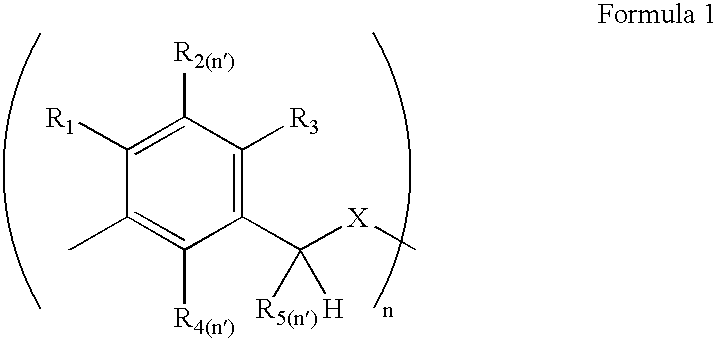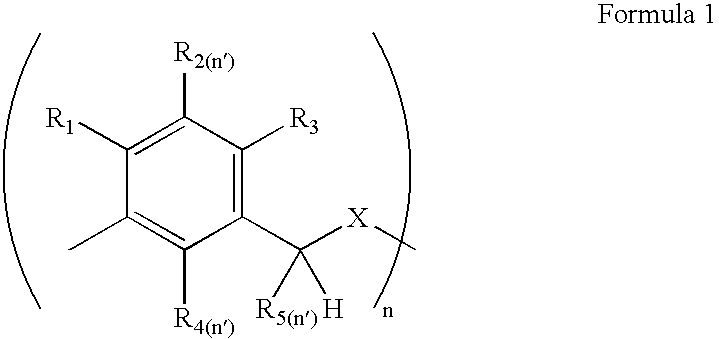Novel calixarene based dispersible colloidal systems in the form of nanoparticles
a colloidal system and amphiphilic calixarene technology, applied in nanotechnology, cosmetics, pharmaceutical non-active ingredients, etc., can solve the problems of toxic, high time-consuming and expensive purification process, toxic, aldehyde must be removed, etc., and achieve high mechanical stability of the system
- Summary
- Abstract
- Description
- Claims
- Application Information
AI Technical Summary
Benefits of technology
Problems solved by technology
Method used
Image
Examples
example a
Synthesis of Hexa-p-dodecanoyl-calix[6]arene
[0065] Under a nitrogen blanket, 3 g (4.7 mmol) of calix[6]arene, 7.2 g (7 val) of dodecanoyl chloride and 6.3 g (10 val) of anhydrous aluminum chloride are added under anhydrous conditions to 200 ml of dry nitrobenzene. the deep orange solution is stirred during 20 hours at room temperature. The reaction is then quenched by poring the reaction mixture on 1 kg of ice. the reaction product is extracted with chloroform, washed successively with 500 ml 1M hydrochloric acid, 2,500 ml of 1M NaCl solution, and 2,500 ml of deionized water. The organic phase is dried on magnesium sulfate, and the solvent is evaporated in vacuo until a final volume of 50 ml. The brownish orange residue is added to 500 ml of methanol, and the fine precipitate is filtered off and dried in vacuo. The white powder thus obtained is analyzed by NMR, and the structure of hexa-p-dodecanoyl-calix[6]arene is ascertained. Yield: 50%.
[0066] In modifying the amounts of the ca...
example 1
Preparation of a Nanoparticle Dispersion
[0067] This Example illustrates the typical working technique for the manufacture of the compositions of this invention.
[0068] The preparation of calixarenes modified by coupling a 12 carbon atom acyl chain in the para position to phenolic hydroxyl function is for example described in Shahgaldian et al. (loc. cit.) See also Example A above.
[0069] Tetra-p-dodecanoyl-calix[4]arene is dissolved in a suitable solvent, in the case of this example tetrahydrofuran, to generate phase (2) (3 ml). Phase (2) is added to an aqueous phase is (3) (100 ml) under magnetic stirring. The medium immediately becomes opalescent by formation of modified calix[4]arene nanosphere. The average size of the nanospheres, measured by a laser-beam diffractometer (4700C from Malvern), is 150 nm with an average dispersion index of 0.1.
[0070] The suspension may be concentrated under reduced pressure to the desired volume, for example 10 ml or thereabouts.
[0071] The appea...
example 2 (variant of example 1)
[0072] The method is carried out as in Example 1, but by adding the aqueous phase (3) to the tetrahydrofuran phase (2). The nanosphere dispersion obtained has the same characteristics as those described in Example 1.
PUM
| Property | Measurement | Unit |
|---|---|---|
| Percent by mass | aaaaa | aaaaa |
| Size | aaaaa | aaaaa |
| Weight | aaaaa | aaaaa |
Abstract
Description
Claims
Application Information
 Login to View More
Login to View More - R&D
- Intellectual Property
- Life Sciences
- Materials
- Tech Scout
- Unparalleled Data Quality
- Higher Quality Content
- 60% Fewer Hallucinations
Browse by: Latest US Patents, China's latest patents, Technical Efficacy Thesaurus, Application Domain, Technology Topic, Popular Technical Reports.
© 2025 PatSnap. All rights reserved.Legal|Privacy policy|Modern Slavery Act Transparency Statement|Sitemap|About US| Contact US: help@patsnap.com


